The Age of Apple Begins: Inside the New MLS League Pass Studios in NYC and the League’s ‘Connected-Production’ Ecosystem
The team is deploying a mix of NEP mobile units and production and data-center facilities
Story Highlights
It’s a new day for Major League Soccer, which will kick off its 10-year rights deal with Apple this weekend. In addition to carrying every game, Apple’s newly launched MLS League Pass streaming service will feature an MLS 360 whip-around show, as well as MLS Countdown and MLS Wrap-up studio shows — all produced from the league’s brand-new production center in New York City.
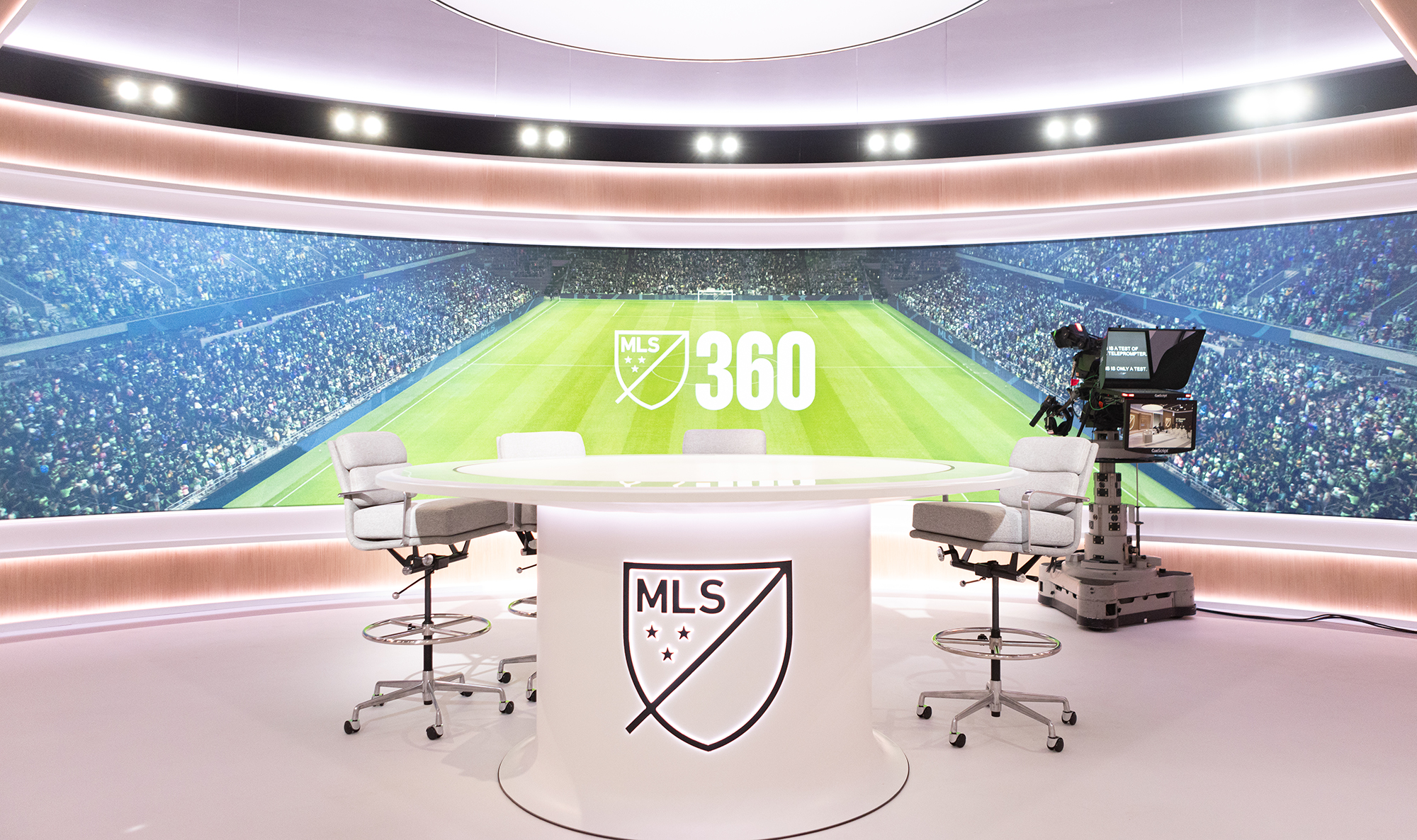
The new MLS 360 set features multiple looks, including this pedestal desk.
“We’re going to be doing studio shows every week,” said Gary Stevenson, deputy commissioner, MLS and president/managing director, MLS Business Ventures, at a media event on Wednesday. “It’s going to allow fans to get in and out of matches. This [new service] is really fan-focused. We’re just thrilled to be here and go to work on Saturday and deliver this great content to the world.”
In addition to launching impressive new studios within the MLS production hub in NYC, MLS and Apple have also partnered with NEP Group and IMG Productions to produce more than 950 matches representing more than 2,000 hours of live coverage in a mix of English, Spanish, and French. To pull this coast-to-coast effort off, NEP is providing dozens of mobile units at MLS venues and has built a connected ecosystem that leverages its centralized-production facilities and technological infrastructure in Dallas, Los Angeles, New York, South Florida, and Washington, DC.
Inside the Studios: Despite Condensed Timeline, New Sets Are Ready for Opener
MLS’s new production facility were built at NEP’s Metropolis studio location in East Harlem, previously home to shows like BET’s 106 and Park, Comedy Central’s Chappelle’s Show, and Food Network’s Chopped. The centerpiece is a 6,500-sq.-ft. set featuring a massive 55- x 17-ft. 1.5-mm LED screen weighing in at 6,000 lb. and is the largest of any studio in New York City. In addition to the main studio, which serves as home to the new MLS 360 RedZone-style whip-around show, the facility houses two smaller sets for English and Spanish versions of the pre/postgame and halftime shows.
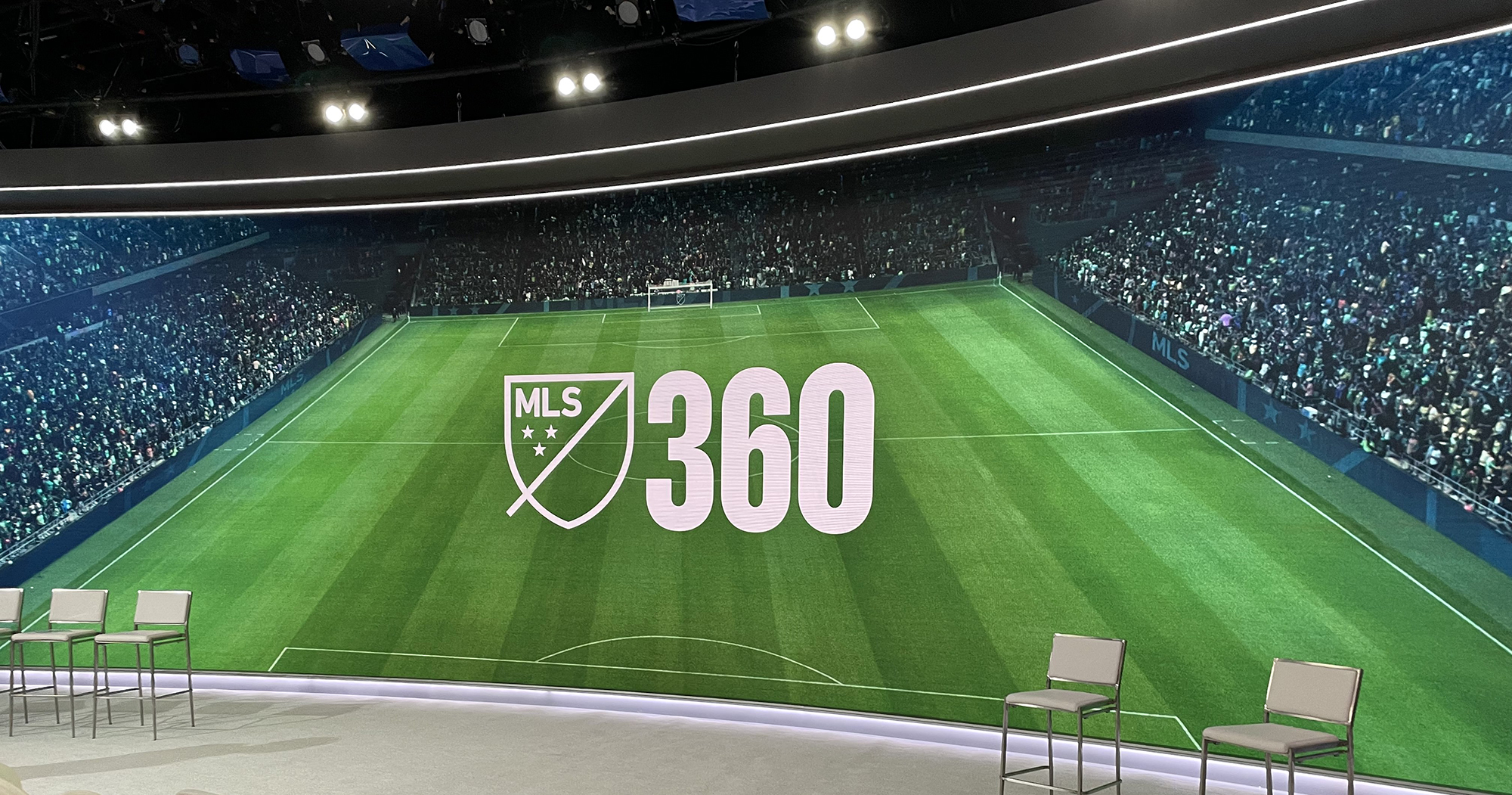
The new 55 -x 17-ft. 1.5-mm LED screen is the largest in any studio in New York City.
“I think [the studios are] emblematic of the focus that Apple has on design and are trying to use design as a way to improve the customer experience,” said Jim DeLorenzo, head of sports, video business, Apple. “But a ton of credit here should go not just to the Apple team but to MLS, NEP, and IMG to bring this all together. When you look at this studio and you see all these different spaces, it’s going to allow [MLS] to have a dynamic broadcast over the five-plus hours of a match night.”
As part of the project, NEP fully refurbished existing studio space, control room, and audio room — all now being used by MLS 360 — with the latest equipment. Although control surfaces for the switcher, replay, graphics, and so on are in the control room, the technical infrastructure is located at NEP’s data center at Equinix’s DA11 facility in Dallas.
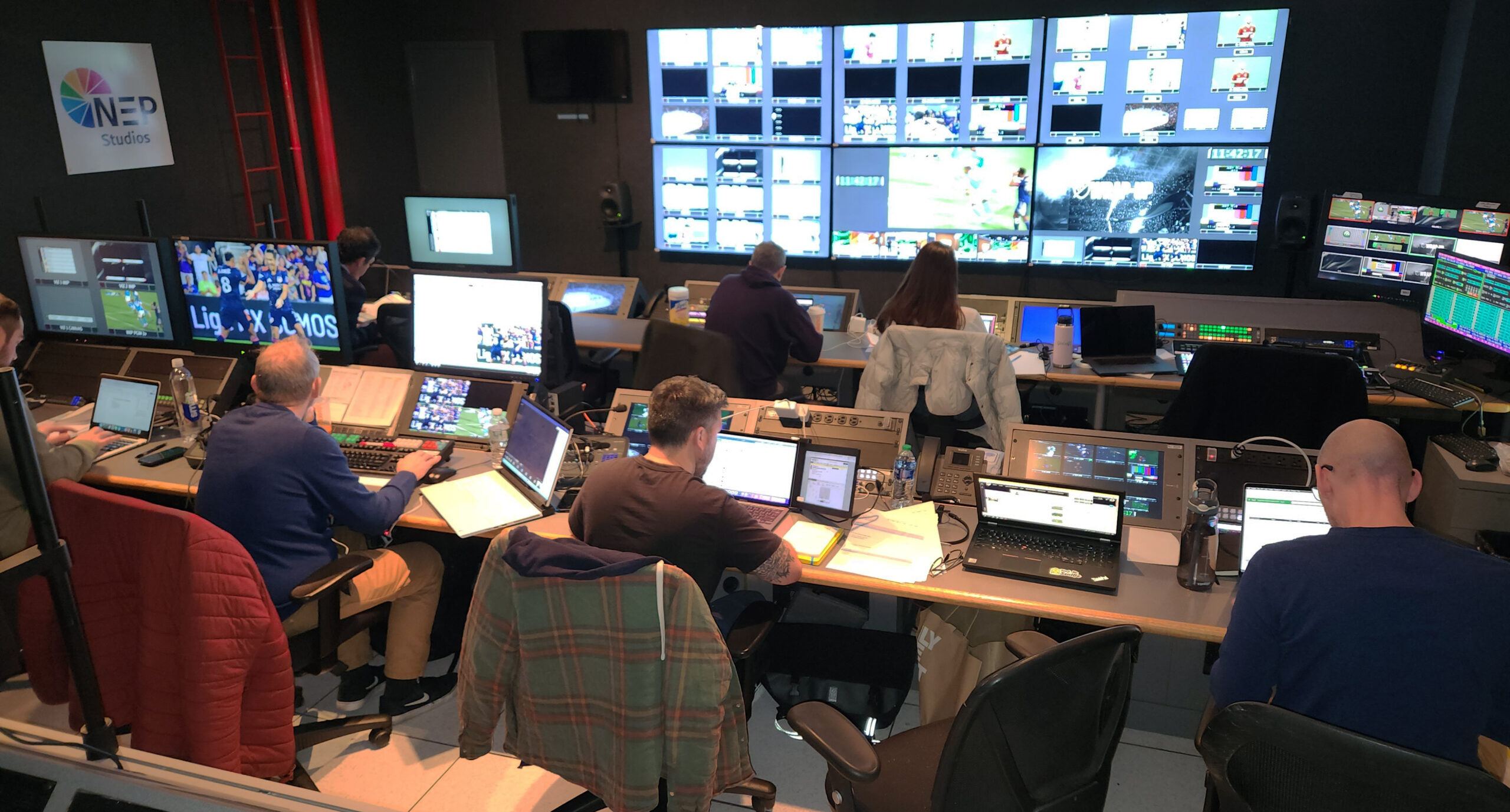
The production-control room for the MLS 360 studio was fully refurbished in advance of the launch.
The other two studios and their corresponding control rooms and audio rooms were built from scratch with equipment racks onsite. In addition, NEP constructed a dedicated EVS replay room, 12 edit suites, and office space for a variety of MLS, IMG, and NEP production staff.
The main LED display was provided by NEP’s Creative Technology arm, and the majority of the equipment was provided by Bexel and integrated by NEP’s in-house system-integration team.
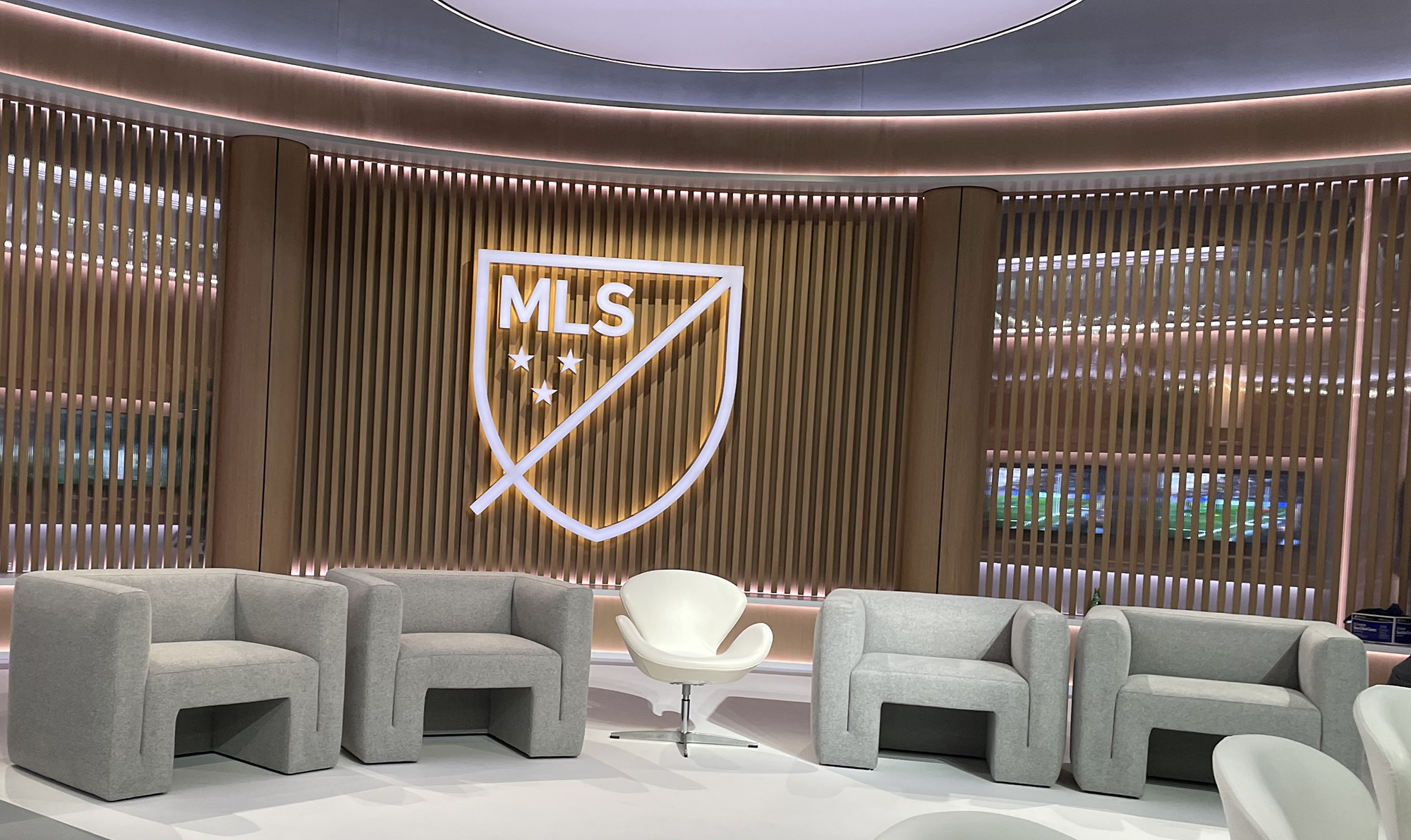
This panel area is one of several looks inside the MLS 360 studio.
Construction took place on an ultra-short timeline: the previous tenant moved out of Metropolis Studios on Dec. 17, and physical construction and technical integration began just after the New Year. Just six weeks later, the new MLS Season Pass studios were up and running for rehearsals, and the facility will make its grand debut tomorrow on the first match day of the season.
“It was the effort of a ton of people from MLS, Apple, IMG, and NEP to create this space,” said Global President, NEP Broadcast Services, Mike Werteen. “It was an extremely short timeframe for the actual buildout, so we had to have everything in place ahead of time.
“I can’t overstate how much of a priority NEP has put on this project — not just the studio but the entire connected-production ecosystem,” he continued. “[For] more than 200 people in seven states and five countries for the past five months, it has been their primary responsibility to make this happen. And then hundreds more from our teams around the globe have touched [this project] in some fashion. It has been an absolutely unbelievable effort by everyone involved.”
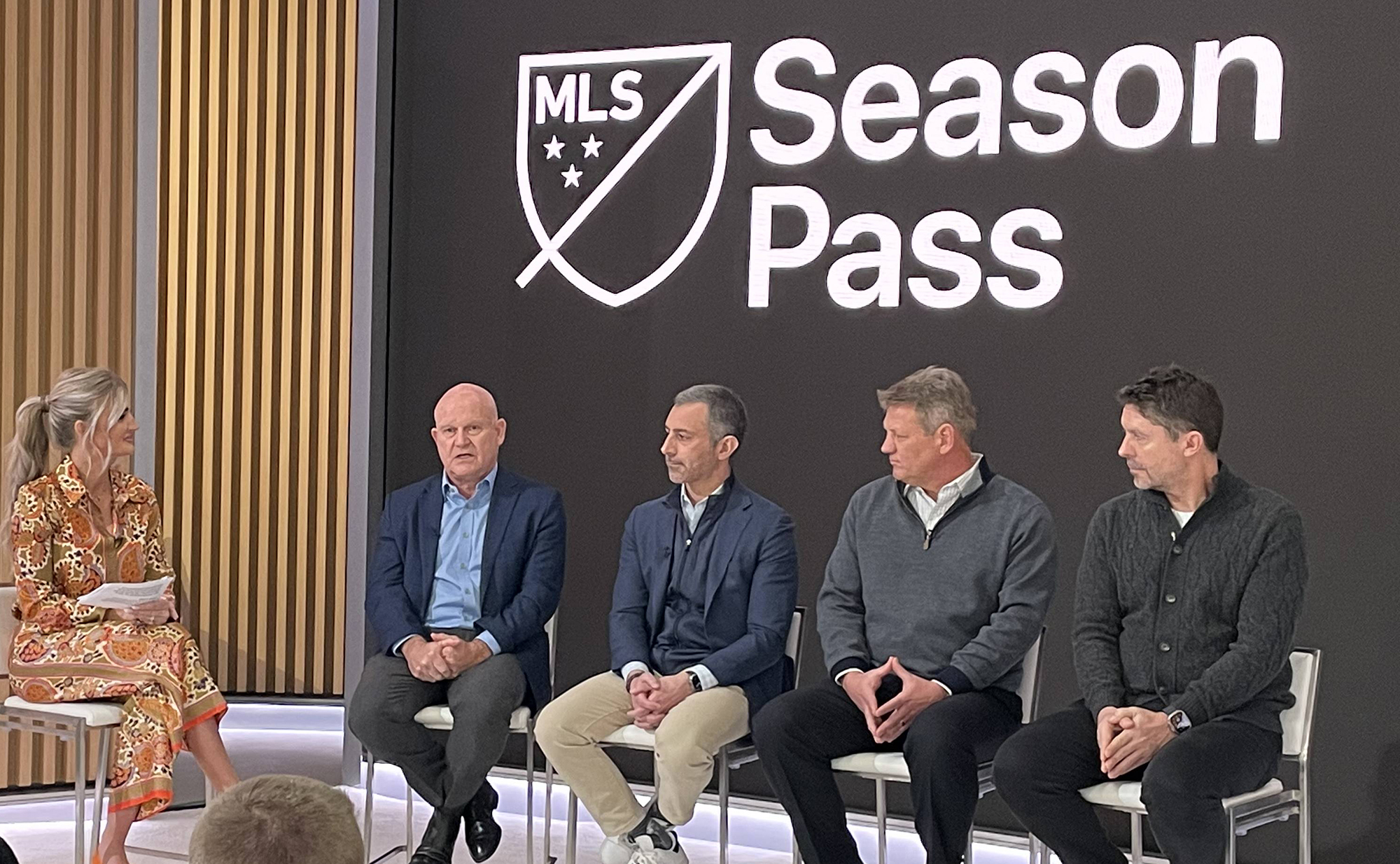
On the new MLS set, (from left) MLS on-air host Kaylyn Kyle moderates a panel comprising MLS’s Gary Stevenson, Apple’s Jim DeLorenzo, NEP’s Mike Werteen, and IMG’s Barney Francis.
The new MLS 360 provides live look-ins from every match, showcasing every goal, penalty kick, and big save and providing analysis and discussion throughout each match night.
“Whip-around shows aren’t new, but our whip-around show is going to bring to life the [on-air] talents that we have and bring to life all the goals as they happen,” said Barney Francis, EVP, IMG. “It’s going be light, but it’s also going to be serious where it needs to be. We are giving people a one-stop shop if you want to watch all the goals and all the [key moments] from the whole afternoon of football in the MLS.”
In addition, MLS Countdown pregame shows will be available in English and Spanish prior to every single match; MLS Wrap-Up offers a full recap of the day’s action with live postgame coverage available in English and Spanish.
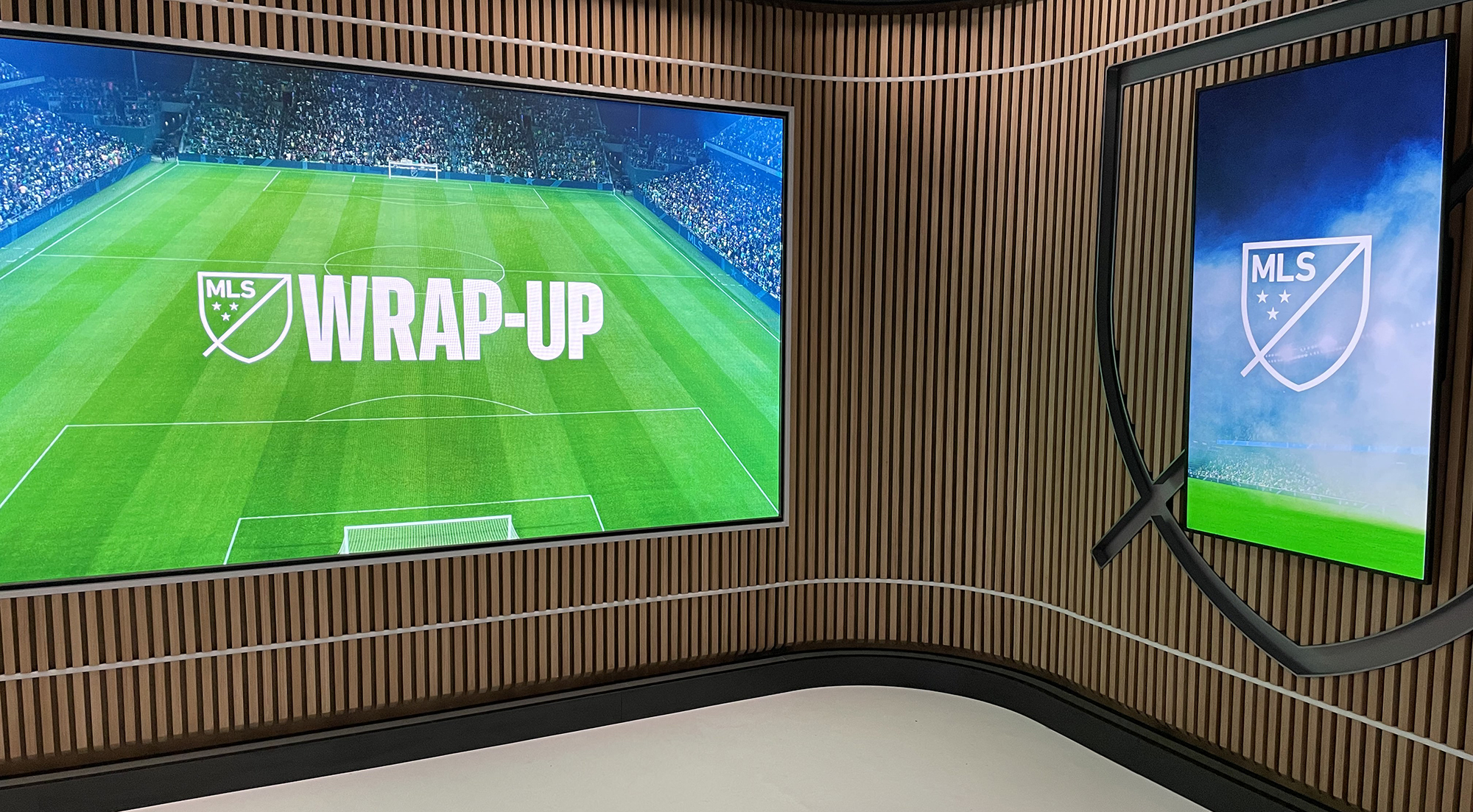
Two new studios were built from scratch to serve the English and Spanish versions of MLS Countdown and MLS Wrap-Up.
‘Connected-Production Ecosystem’: Producing MLS Matches Coast to Coast
Although all MLS matches will be produced onsite using mobile units, MLS and Apple are using several NEP production and data-center facilities across the country as part of the MLS Season Pass production operation.
Stevenson said that, four years ago, the league undertook a consumer- research project that revealed that “our video and live-production product was just not good enough. And so, at that moment, we decided that there was a way for us to build a new product.”
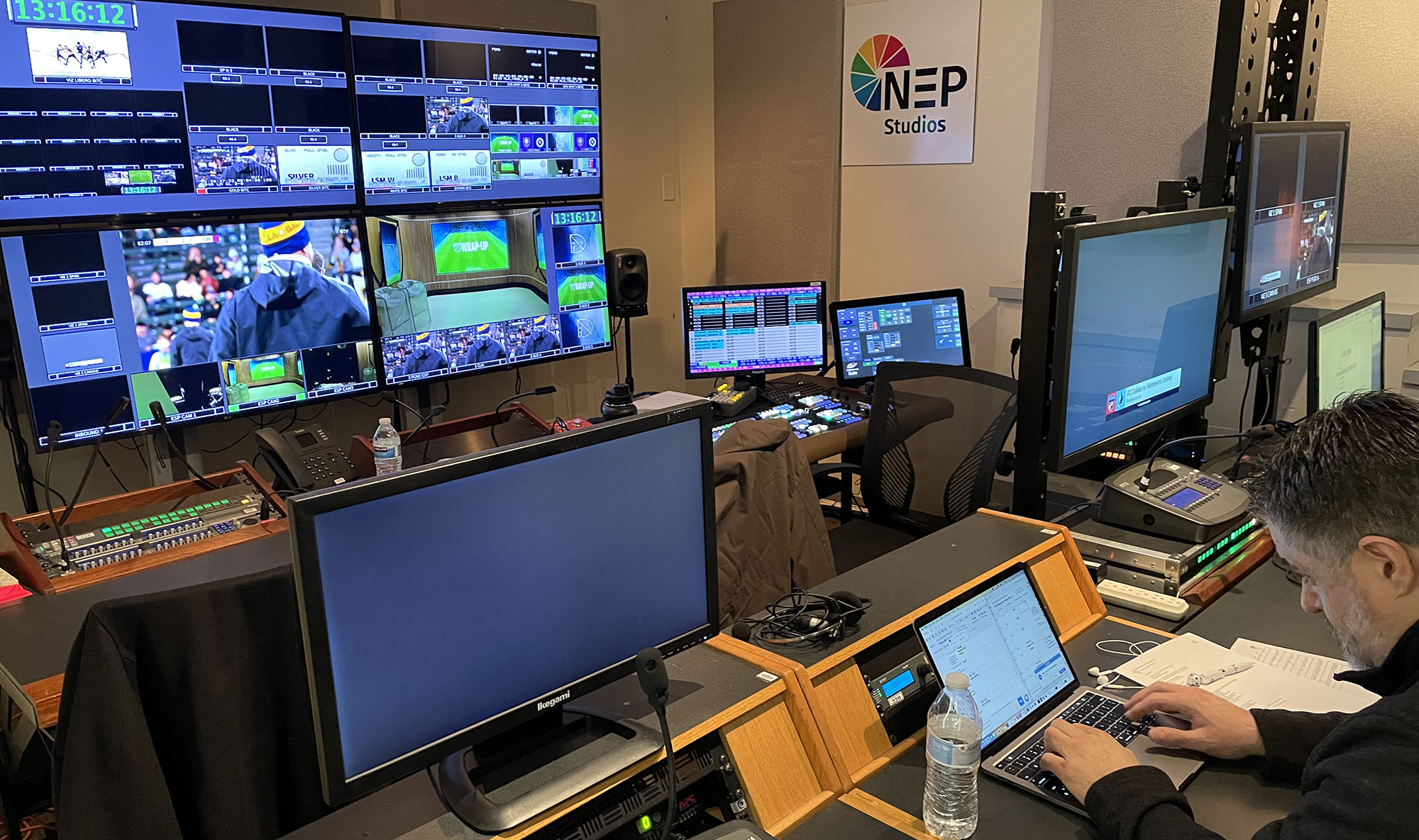
One of two control rooms built to serve the pre/postgame and halftime shows at MLS Season Pass studios
However, instead of building a pricey owned-and-operated physical facility, the league was looking to leverage existing partnerships with NEP and IMG — along with advances in remote-production technology and connectivity — to create a more agile production ecosystem.
“What’s interesting about this is, we knew that we wanted to do our own production, but we also knew that, because of the changing of technology, the ability to move video and data content between stadiums and to a facility and even overseas is so much easier now,” said Stevenson. “You don’t have to have a facility where you own one huge structure, which happens so much — especially in linear programming today.
“We had all the pieces in place to do our own production,” he continued. “We had been partners with NEP for 22 years, and we’ve had a lot of reps with them in a lot of areas. We’ve been partners with IMG for over 10 years, doing some production services globally. And we’ve been partners with AT&T, who is the best in the world at moving video and data content around.”
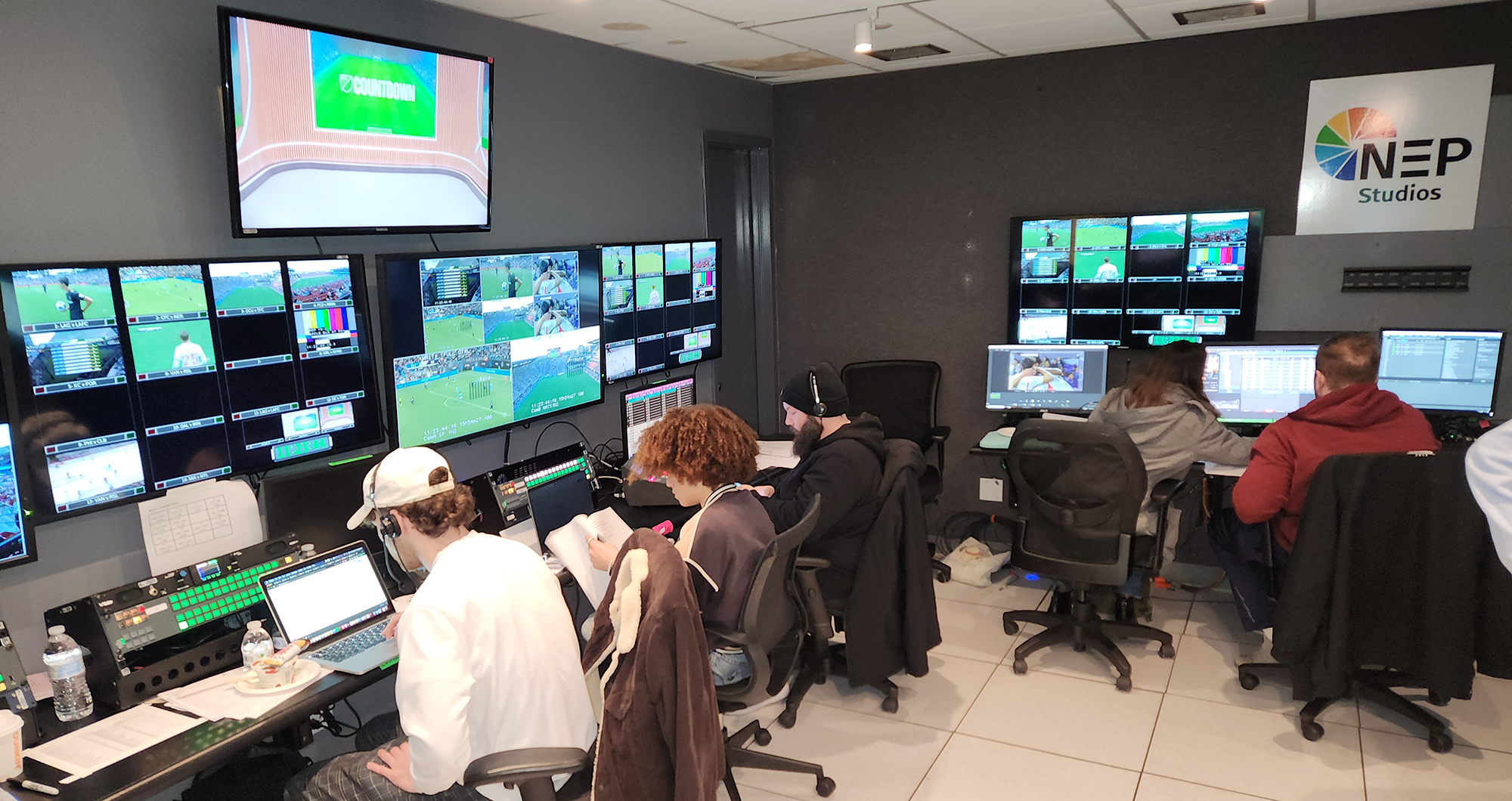
A full EVS room was constructed to serve the robust MLS 360 whip-around show, as well as MLS Countdown and MLS Wrap-up.
The MLS League Pass production model starts at the stadium, with NEP mobile units producing a world feed and English and Spanish feeds (and French when necessary) with announcers onsite. The 1080p feeds (along with 16 channels of embedded audio for 5.1 surround sound) are sent to NEP’s data center in Dallas before being distributed to multiple locations: Vista Worldlink centralized-production center in South Florida (which is managing connectivity and distribution and is responsible for remote productions of the MLS Next and MLS Next Pro games); Media NEP’s Mediabank media-asset–management operation in Washington, DC; the Apple Live Operations Center (ALOC) at the NEP Production Center in L.A. (which handles playout and commercial insertion); and the new studios in New York City.
At the heart of it all is NEP’s new Total Facility Control (TFC) proprietary web-based control platform, which brings disparate systems for audio- and video-signal configuration and monitoring under one application.
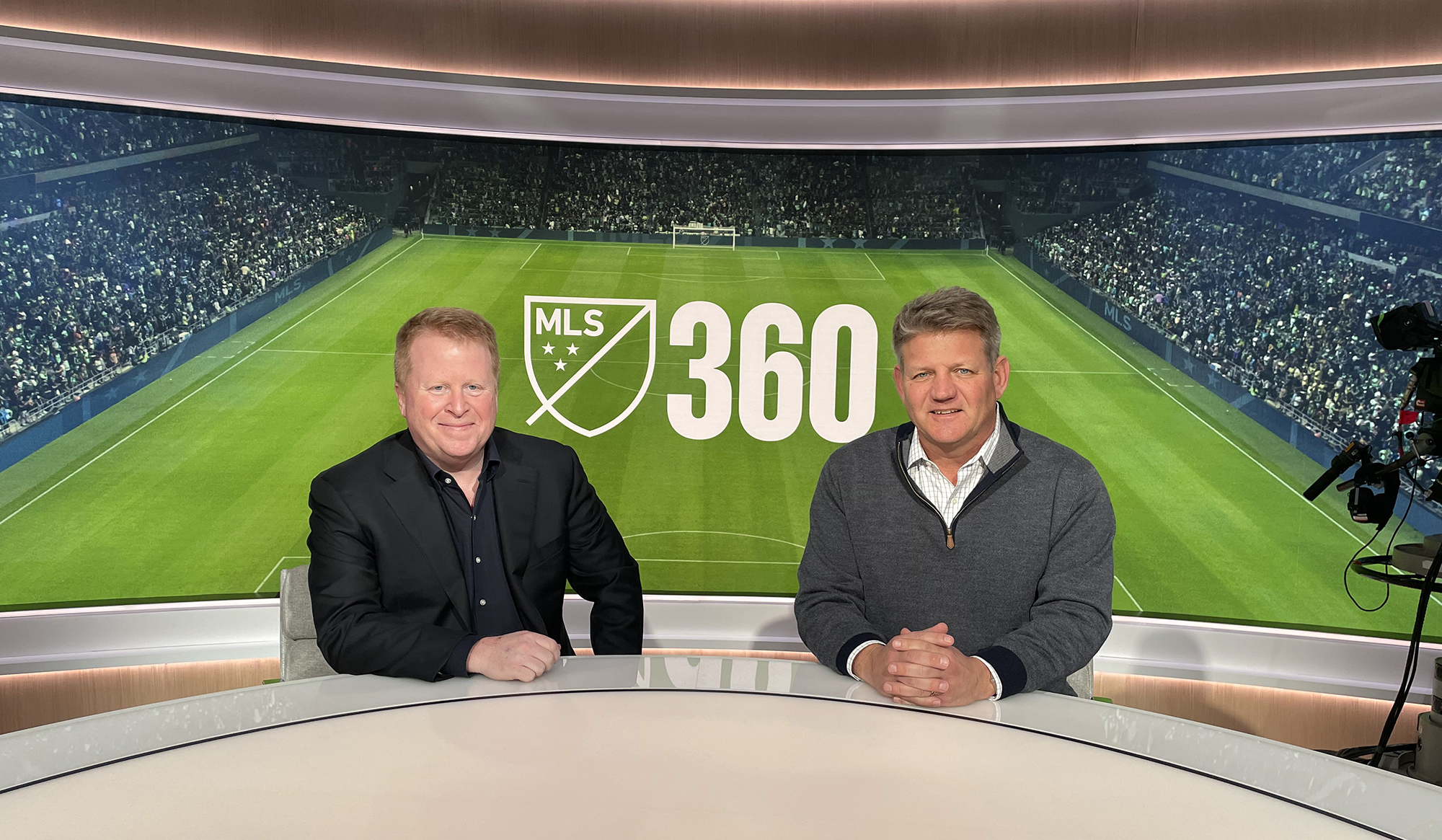
NEP’s Brian Sullivan (left) and Mike Werteen on hand at the new MLS Season Pass studios
“This doesn’t happen without a client who has a vision that no one has had before – particularly in the U.S.,” said NEP Group CEO Brian Sullivan. “If you don’t have MLS and Apple leaning into this [concept], none of this comes together. And then you add in that the timeline was so tight to do all this. To see all the teams come together and be able to accomplish it was unbelievable.”
NEP has stood up a dedicated operations team to coordinate mobile units, crews, and distribution for as many as 14 games on a match day, and IMG oversaw recruitment of producers, directors, and other production talent who will man the trucks at each venue. Stevenson said he “would put our producer and director [teams] up against anybody in the world.”
Francis added, “What you’ve seen here is the manifestation of what we are trying to create for every single match. We’ve got producers and directors [and announcers] all over the country who are going to bring these games to life.”
